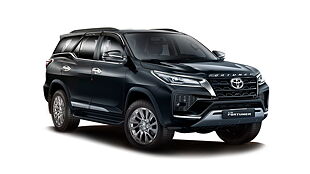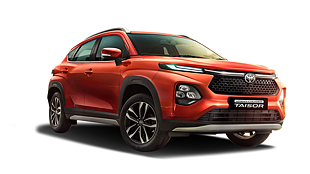Introduction

Most cars in today's time don’t see roads beyond their owner’s commute, and that’s a crying shame. We haven’t refined the motor car for over a century merely so we don’t have to mingle with the great unwashed on the way to work. They’re made to run in conditions ranging from below freezing to temperatures high enough to fry an egg. There’s also the aspiration of a car buyer… Should I want to go for a holiday, my car should do it with ease. Enter the two choices you have, the MUV and the SUV. We have here the two best examples for a holidaying vehicle in the Toyota Innova Touring Sport (it’s even got ‘Touring’ in its name!) and the Hyundai Creta, the SUV of choice for the regular Joe who isn’t an all-out enthusiast. We’ve driven the two of them to Delhi and back with a bunch of characters from the Edit team. Here is how everything panned out.

Expedition

It all started when we had to collect both the cars from their respective dealership in the middle of the busy Mumbai city on a Sunday afternoon. On our roads – dominated by hatchbacks, crowded by two-wheelers and thronged with pedestrian – both these cars felt slightly ‘large’ but not uncomfortably large. The Korean crossover felt like driving a raised hatchback without a hassle over poor quality roads of our metropolitan. Meanwhile, the automatic gearbox of the Touring Sport liberated us from the tension of bumper to bumper traffic of Mumbai’s weekend evening. The Innova did feel considerably large but was easily manoeuvrable. And both the cars getting rear-view camera helped in parking as well.

So the morning after, we set out on our long haul. The challenge that lay ahead was simple. These cars had to do the long stretch of open road, they needed to have the ability to deal with bad roads, or ability to soldier on long stretched without any fuel pumps, they need to be comfortable and spacious to carry four people and their luggage. And both these cars had a trick up their sleeve to deal with these challenges.
The Toyota proved why it has got its cult following. The Innova is a true-blue people carrier, a mile-muncher and rock solid in every test you put it through. We loved the Touring Sport treatment which adds more features and it stood out due to its red hue. And the cherry on the cake was that it was an automatic, albeit an old-school torque converter. But the freedom from the third pedal is always a delight, especially on such a long, arduous journey. It needs to be mentioned here that during the first quarter of our journey from Mumbai, the Innova was running low tyre pressure. This combined with an enthusiastic driver behind the wheel – we are looking at you Omkar – the fuel economy of the Innova was not something to write home about. Meanwhile, the impressive efficiency of the Creta made sure that it stopped for fuel only half as many times as the Innova, and that’s no small feat.

On the downside, the Creta barely squeezed in four people with little room for more. The luggage area was good for its size, but nothing compared to the Innova when we put the third row down. And most importantly, the Creta left us wanting for some additional features such as range/distance-to-empty reading or the real-time fuel consumption which is not even available in the top-spec Creta (we had the SX trim). Even with the ‘captain seating’ in the middle row, the Innova had enough room at the back and it aided us since we kept working on our laptops as the kilometres passed by. The Innova’s multi-colour infotainment screen and the multifunction display were top-notch and it gives a scorecard with respect to how you were driving. Once you actually understood how to properly use the automatic transmission, the Innova had plenty of torque in reserve for you to whiz past slow-moving trucks on the highway at a moment’s notice. Of course, when you have an engine displacement of nearly 3.0-litres like the Innova does, you don’t get to be proud of reserve torque... you’re entitled to it! At the same time, you can actually extract decent fuel economy from the Innova. Cruising at constant 80-90kmph, we even managed to squeeze an impressive 16kmpl on our return journey.

On the other hand, in the Creta, you don’t even have to try to achieve that figure. Regular driving will give you at least 16kmpl, SUV or not. Remember, it’s got an equal number of gears, much less weight, fewer transmission losses, and an engine that was down to the displacement of a Grand i10. And it still managed to keep up with the Innova on the highway quite comfortably. Sure, the Creta is a little stiffer, but cruising at 100kmph or higher becomes that much better because of it. It also felt a little more in control off the throttle because it doesn’t coast like the Innova does.

That aside, when you are travelling long journey, the passenger comfort also needs a special attention. The Korean crossover’s rear bench wasn’t very comfortable to be in for longer durations. The rear AC vents barely managed to keep the passengers cool. On the entire journey, there was a constant request to the front seat passengers to keep adjusting the controls. No such problems were present in the MPV, thanks to the adjustable blower for the rear vents. The brakes on the MPV were brilliant as well, stopping the heavy car (almost 2.5 tonnes) with ease, no matter what. The bright LED and projector headlights were a big boon on unlit highways. The Innova also had a cruise control feature which again helped in the long tiring journey. But the torque converter that coasts, combined with a vague steering and the weight of a rhinoceros did not a good driver’s car make. The Creta felt positively svelte in comparison, and we could dart about, maintaining momentum and that fuel efficiency figure while threading your way between slower vehicles.

The roads were a bag of mixed surprises all the way on our drive. The national expressway between Ahmedabad and Vadodara in Gujarat was a great boon. The smooth stretch of tarmac with three lanes on each side, closed from the surprising intrusions did help us cut some time which was wasted on under construction roads. Some road stretches of Rajasthan was undergoing widening work with no warning whatsoever. On those sections we were driving during twilight so we did caught-out a couple of times there. Then the poor road manners of people sharing the road helped little with the experience. When in Delhi, past the peak hours, yet we faced the horrendous traffic which Venkat calls “death by IGI”. It took us nearly two hours to cross the four-kilometre patch of the eight-lane road right outside the international airport. But we could take it in stride because we belong to Mumbai.

Conclusion

As with everything else, each car had advantages and disadvantages. But, both our cars returned back with big smile on our faces. They both tackled all the challenges thrown at them with ease. And there is now no questioning whether one should take an MPV or a compact SUV on an expedition such as ours. While, the fact remains that both Hyundai and Toyota products in India have got a solid reputation for reliability backed up with great service.

Fact file:
Number of food stops: More than required.
Number of states crossed: Six.
Number of selfies taken: not much actually.
Words - Charles Pennefather and Bilal Firfiray
Pictures by Kaustubh Gandhi

![Toyota Innova Crysta [2016-2020] Image Toyota Innova Crysta [2016-2020] Image](https://imgd.aeplcdn.com/272x153/n/cw/ec/20623/innova-crysta-exterior-right-front-three-quarter.jpeg?q=80)
![Toyota Innova Crysta [2016-2020] Right Front Three Quarter Toyota Innova Crysta [2016-2020] Right Front Three Quarter](https://imgd.aeplcdn.com/199x112/n/cw/ec/20623/innova-crysta-exterior-right-front-three-quarter.jpeg?q=80)
![Toyota Innova Crysta [2016-2020] Right Side View Toyota Innova Crysta [2016-2020] Right Side View](https://imgd.aeplcdn.com/199x112/n/cw/ec/20623/innova-crysta-exterior-right-side-view.jpeg?q=80)
![Toyota Innova Crysta [2016-2020] Right Rear Three Quarter Toyota Innova Crysta [2016-2020] Right Rear Three Quarter](https://imgd.aeplcdn.com/199x112/n/cw/ec/20623/innova-crysta-exterior-right-rear-three-quarter.jpeg?q=80)
![Toyota Innova Crysta [2016-2020] Dashboard Toyota Innova Crysta [2016-2020] Dashboard](https://imgd.aeplcdn.com/199x112/n/cw/ec/20623/innova-crysta-interior-dashboard.jpeg?q=80)
![Toyota Innova Crysta [2016-2020] Steering Wheel Toyota Innova Crysta [2016-2020] Steering Wheel](https://imgd.aeplcdn.com/468x263/n/cw/ec/20623/innova-crysta-interior-steering-wheel.jpeg?q=80)
























